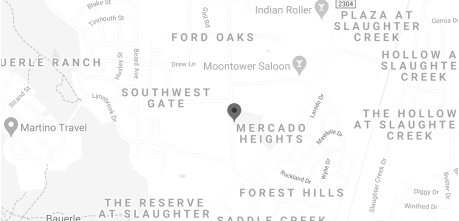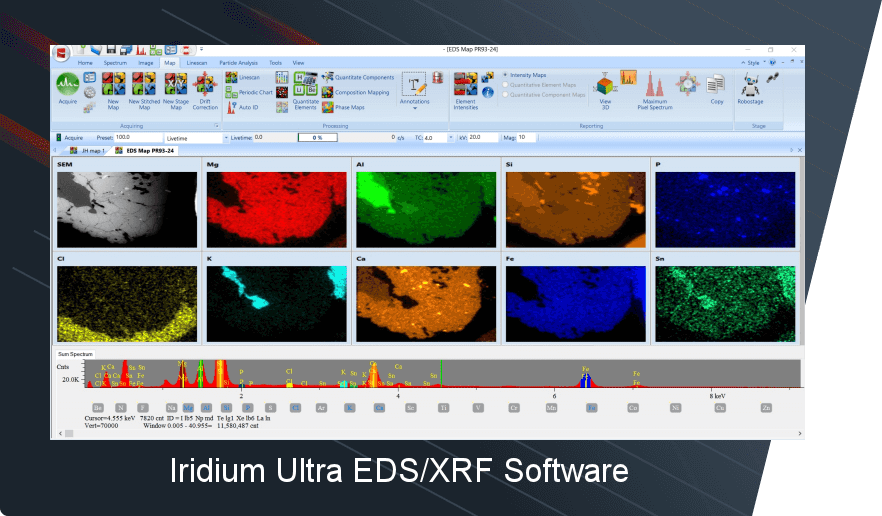Understanding the intricate interactions between plants, soils, and nutrients is vital to sustainable crop production and effective agricultural environmental management. High-resolution micro X-ray Fluorescence (microXRF) technology, such as the Atlas microXRF from IXRF Systems, provides an essential tool for non-destructive elemental analysis, offering new insights into these relationships. This article examines how microXRF, specifically using the Atlas microXRF, is being applied in agriculture, from mapping nutrient distribution in crops to identifying contaminants and hyperaccumulator plants. We’ll explore examples our customers collected, such as Brazil nuts’ elemental composition, metal hyperaccumulation in Papua New Guinea, and tree ring analysis for environmental research.
Elemental Mapping in Brazil Nuts
One area where microXRF has shown particular value is in studying the elemental composition of Brazil nuts. These nuts are known to contain high levels of elements like selenium and bromine, sometimes exceeding regulatory thresholds. Researchers have used microXRF to determine that the elevated bromine levels in Brazil nuts result from the nuts’ natural ability to absorb bromine from the soil rather than contamination during processing, such as from fumigation.
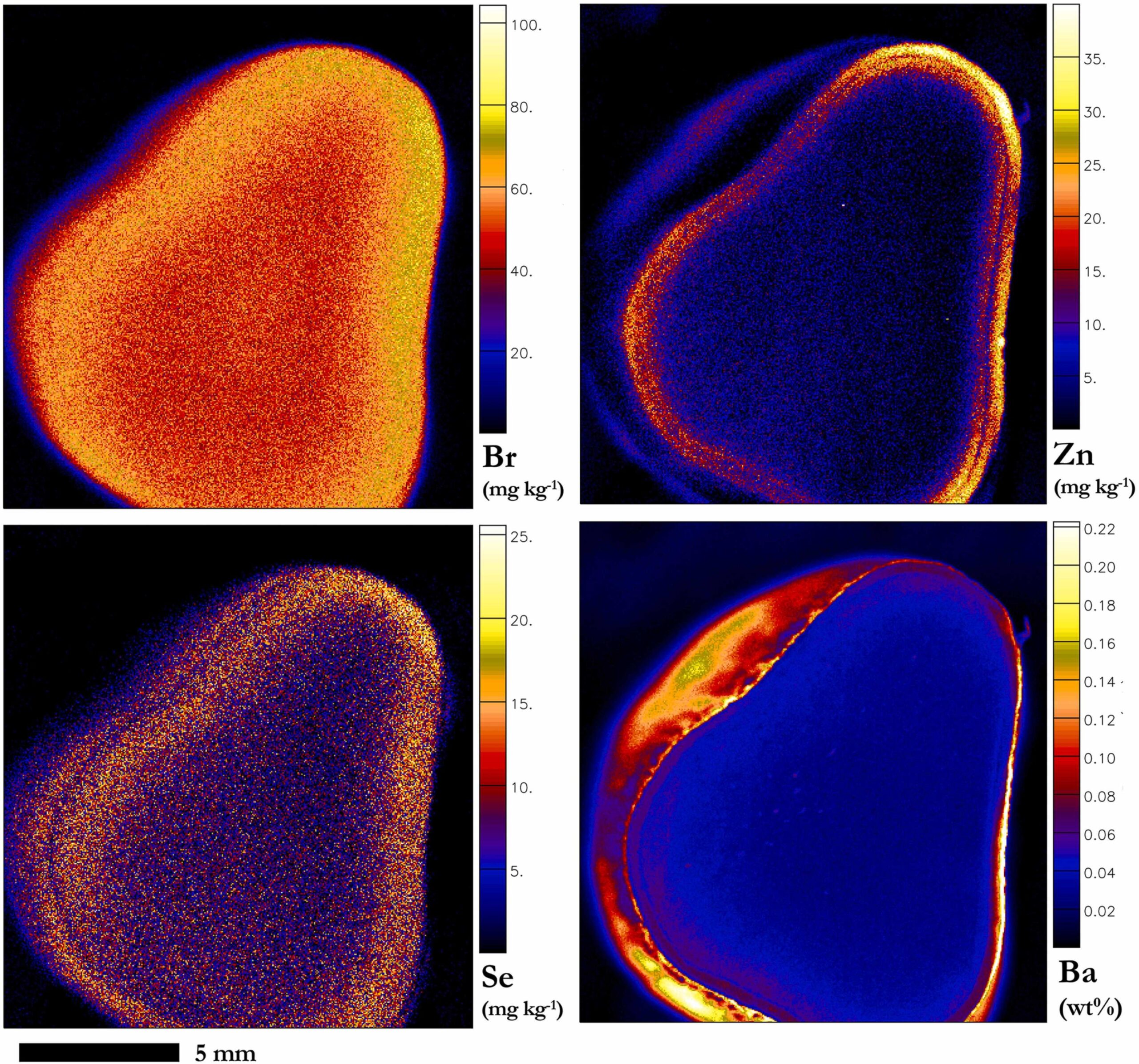
Figure 1: MicroXRF elemental maps of a transverse cut Brazil Nut kernel showing the distribution of Br, Zn, Se, and Ba.
This finding has important implications for food safety and regulation. MicroXRF helps refine safety standards and informs agricultural practices by distinguishing natural elemental accumulation from contamination. In the case of Brazil nuts, it clarified the origin of bromine, aiding in better risk assessments and management strategies for both producers and consumers. (High natural bromine concentrations…)
Identifying Hyperaccumulators in Plant Species
MicroXRF is also valuable in environmental research, particularly for identifying hyperaccumulator plants—species that can absorb large quantities of metals like nickel, manganese, and zinc. A study conducted in Papua New Guinea used microXRF to analyze over 3,000 plant specimens and identified several hyperaccumulator species. One such species, Grevillea papuana, was found to accumulate zinc in remarkably high concentrations.
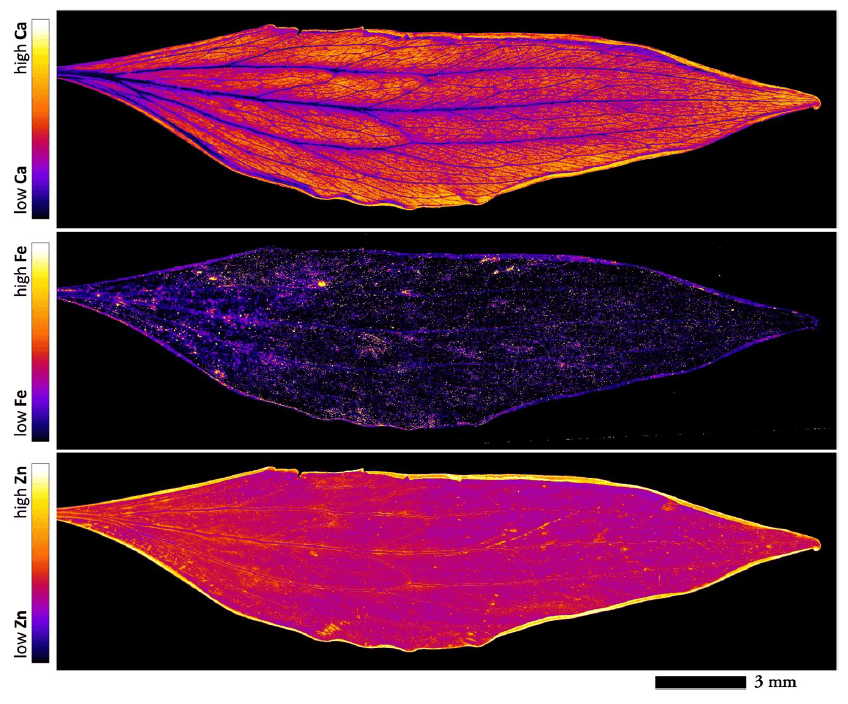 Figure 2: MicroXRF elemental maps of Grevillea papuana (Proteaceae) specimen showing the distribution of Ca, Fe, and Zn.
Figure 2: MicroXRF elemental maps of Grevillea papuana (Proteaceae) specimen showing the distribution of Ca, Fe, and Zn.
These findings are significant for environmental remediation. Hyperaccumulators can be used in phytoremediation efforts, where plants are cultivated to absorb and remove metals from contaminated soils.
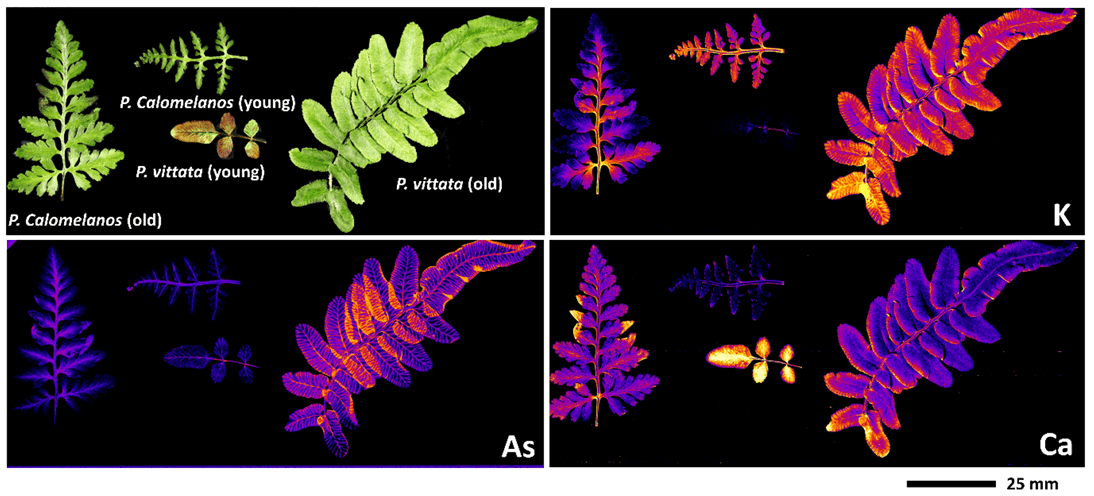 Figure 3: MicroXRF map distribution of K, As, and Ca of younger and older fern species Pityrogramma calomelanos and Pteris vittata.
Figure 3: MicroXRF map distribution of K, As, and Ca of younger and older fern species Pityrogramma calomelanos and Pteris vittata.
MicroXRF enables researchers to map metal concentrations within plant tissues, ensuring that the most effective plants are selected for remediation projects. Additionally, these studies contribute to our understanding of how certain plants evolve to tolerate and accumulate metals. (A preliminary survey of nickel…), (Chemical transformations of arsenic…)
High-Throughput Seed Analysis for Nutrient Research
Recently, microXRF technology enabled a high-throughput approach to seed analysis, as demonstrated by research on rice seeds to map element distribution across plant tissues. A microXRF study examined thousands of rice seeds, identifying various genetic traits associated with nutrient uptake and distribution in specific seed regions like the embryo and endosperm (Fast x-ray fluorescence…).
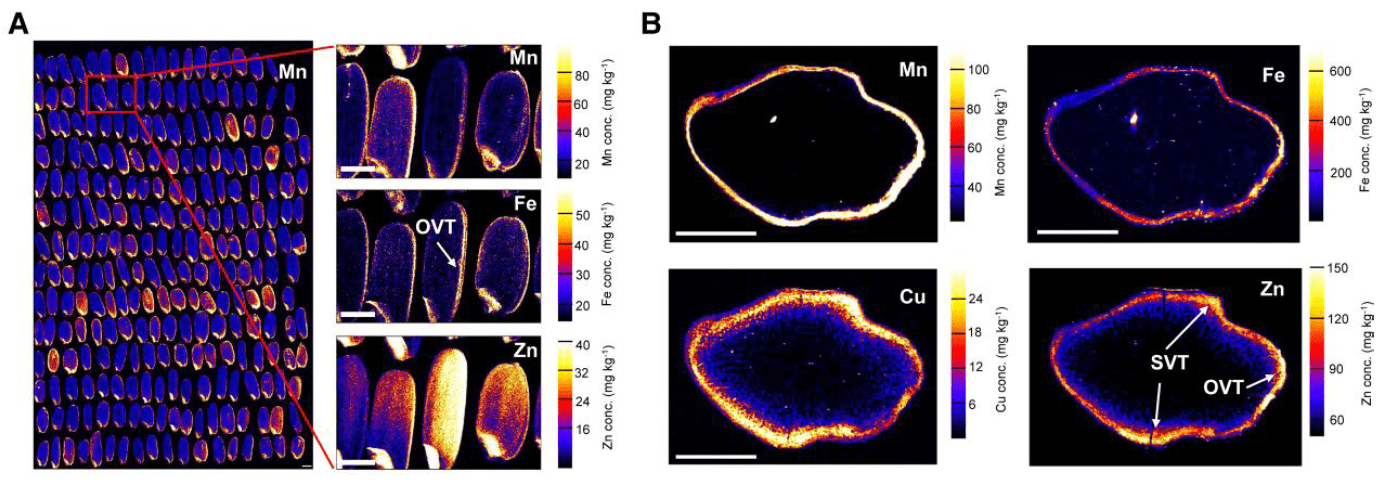 Figure 4: MicroXRF map distribution of Mn, Fe, Cu, and Zn within rice seeds. Section A, Elemental concentrations in the whole seed. Section B, Elemental concentrations in the transverse-cut of seed. The scale bar denotes 2 mm.
Figure 4: MicroXRF map distribution of Mn, Fe, Cu, and Zn within rice seeds. Section A, Elemental concentrations in the whole seed. Section B, Elemental concentrations in the transverse-cut of seed. The scale bar denotes 2 mm.
Such mapping is essential for developing biofortified crops that improve human nutrition. Additionally, this non-destructive method enables researchers to analyze thousands of seeds rapidly, providing a practical solution for large-scale phenotyping.
Optimizing Crop Nutrient Distribution
Another application of the Atlas microXRF is in mapping nutrient distribution within plants. By understanding how nutrients are absorbed and distributed within different plant parts, researchers and farmers can make more informed decisions on fertilizer application. This precision ensures that nutrients reach the crop where they are most needed, reducing the risk of deficiencies or toxicities.
Using Tree Rings for Environmental Analysis
MicroXRF also provides valuable insights into historical environmental conditions by analyzing tree rings. Tree rings are natural records of past climate changes, soil chemistry, and environmental events. By analyzing the elemental composition of tree rings, researchers can gain a deeper understanding of how historical events have influenced agriculture and the environment.
For instance, a study of ancient Mediterranean tree rings used microXRF to detect calcium depletion, likely caused by the eruption of Thera. This event had a significant impact on regional agriculture, and by studying such events, researchers can gain insights into how past environmental changes affected agricultural systems. This knowledge is crucial for developing strategies to address future challenges like climate change and soil degradation. (Securing timelines in the ancient…) 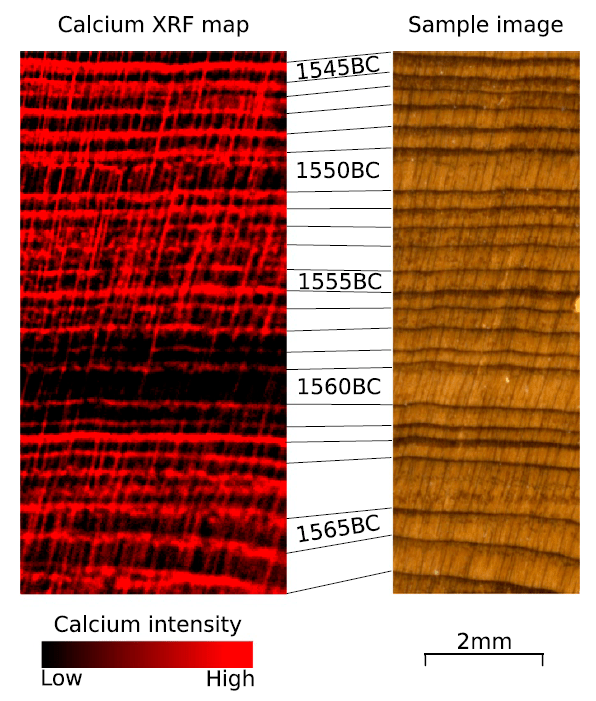 Figure 5: A microXRF scan of the transverse section of Juniperus excelsa wood from the East Mediterranean Bronze–Iron Age featuring an unusual depletion of the element Ca. This scan shows that calcium depletion occurs from around 1562 to 1558 BC and is centered on an unusually wide, slightly pale in color growth ring at 1560 BC.
Figure 5: A microXRF scan of the transverse section of Juniperus excelsa wood from the East Mediterranean Bronze–Iron Age featuring an unusual depletion of the element Ca. This scan shows that calcium depletion occurs from around 1562 to 1558 BC and is centered on an unusually wide, slightly pale in color growth ring at 1560 BC.
Conclusion: The Role of MicroXRF in Agricultural Research
High-resolution microXRF technology opens up new possibilities for agricultural research, offering insights that improve food safety, optimize nutrient use, and enhance environmental management. Whether you’re looking to investigate the nutrient distribution, explore phytoremediation, or assess long-term environmental trends, IXRF Systems’ Atlas microXRF is the tool to help you achieve your research goals.
If you’re interested in starting a project or learning more about how microXRF can benefit your agricultural research, contact us today. Our team can guide you through the possibilities, helping you explore how the Atlas microXRF could meet your needs and lead to future advancements in your field. Contact us to begin your journey toward innovative solutions in agricultural research and environmental sustainability.
Thank you to our valued customers for their continued support and contributions to scientific progress. We look forward to working together to drive future innovations in agricultural research. Contact us to explore how the Atlas microXRF can empower your research and lead to exciting new discoveries.
We’d like to extend our sincere thanks to our customers who generously shared their expertise for this publication. We encourage our readers to dive into the full articles linked above in order to gain valuable insights from their contributions.
References
- Balkanski, Y. et al. “Chemical transformations of arsenic in hyperaccumulator plants.” Plant Physiology, 2021, vol. 185, no. 1, pp. 100-110.
- Fortin, F., & Echevarria, G. “A preliminary survey of nickel hyperaccumulation in the flora of New Caledonia.” Ecology and Evolution, 2019, vol. 9, no. 11, pp. 6935-6944.
- Fukuda, M. et al. “Fast X-ray fluorescence screening of nutrient elements in rice seeds by micro-XRF.” Journal of Agricultural and Food Chemistry, 2022, vol. 70, no. 13, pp. 4000-4011.
- Stephan, T. et al. “Securing timelines in the ancient Mediterranean using elemental analysis of tree rings.” Quaternary Science Reviews, 2023, vol. 298, pp. 107140.
- Weber, F. et al. “Elemental distribution in Brazil nuts using high-resolution XRF technology.” Journal of Food Science, 2020, vol. 85, no. 8, pp. 2225-2233.

